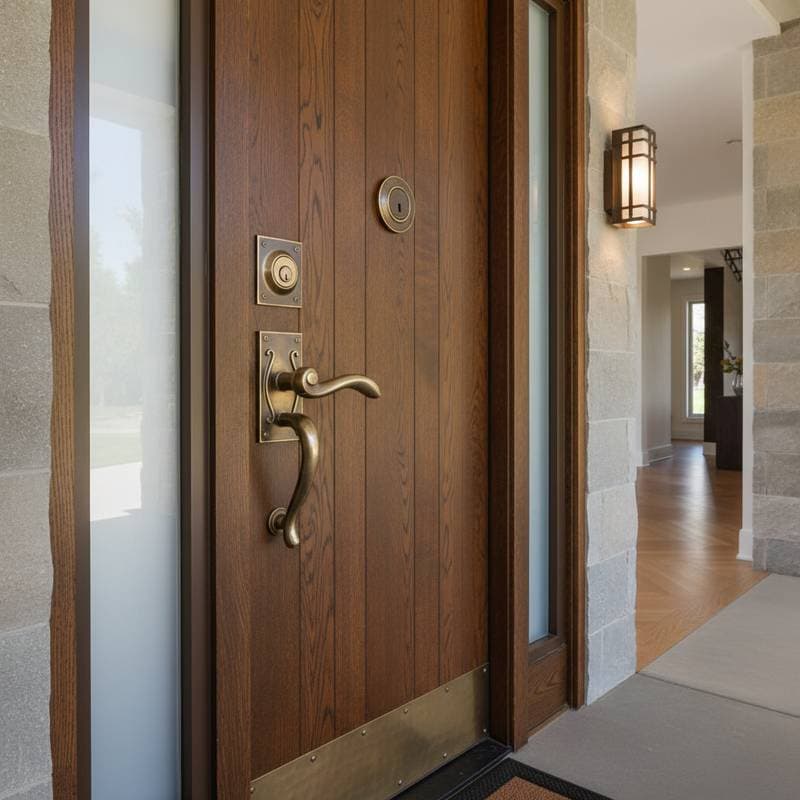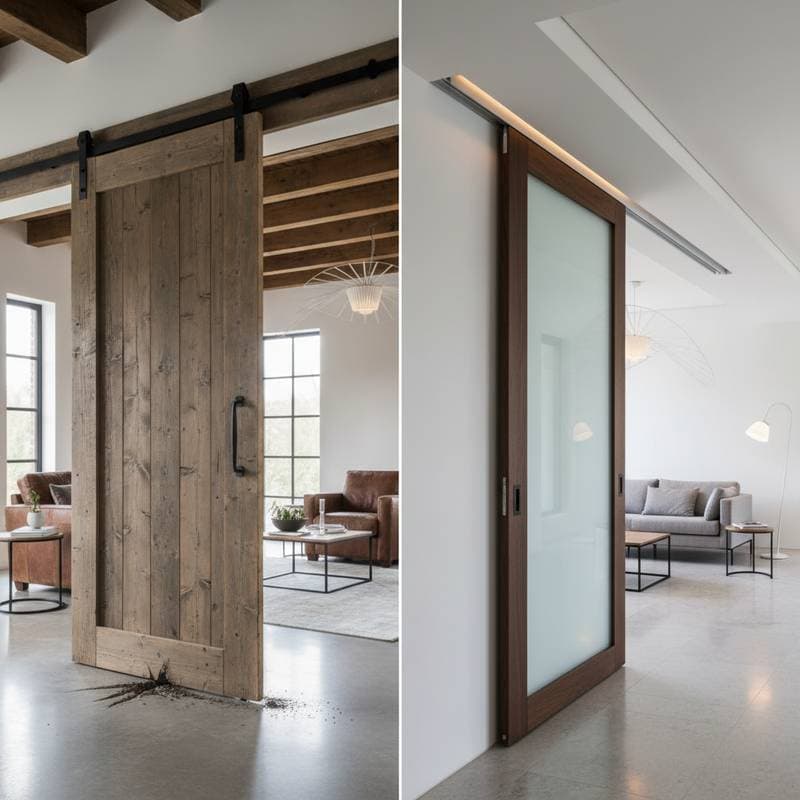Oversized Hardware: The Rise of Substantial Entryway Handles
The entryway establishes the initial impression of any home. Homeowners and designers increasingly select oversized door hardware to convey confidence and refinement. These robust handles and knobs provide visual prominence, sensory appeal, and enduring presence that transform ordinary doors into architectural focal points.
Contrast enhances their effectiveness. In contemporary or streamlined exteriors, oversized hardware introduces texture and personality. In classic or blended styles, such elements inject subtle modernity while respecting existing features. The outcome is an entry door that appears deliberate and inviting.
Approaches to Achieve This Style
Budget-Friendly Option ($300 to $800)
- Select aluminum or powder-coated steel handles that replicate the appearance of bronze or brass.
- Pair with a straightforward door, such as a painted wood or fiberglass panel in a matte finish, allowing the hardware to draw attention.
- Allocate additional funds toward distinctive handle designs and surfaces, like a brushed nickel pull with extended proportions, while using standard hinges and locks.
Mid-Range Option ($900 to $2,000)
- Incorporate diverse materials, including stainless steel accented with wood inserts or matte black combined with brass elements.
- Choose a solid or engineered wood door featuring glass panels that mirror the hardware's form.
- Determine handle dimensions based on door scale; a vertical pull covering at least one-third of the door height promotes equilibrium.
Premium Option ($2,100 to $5,000)
- Invest in high-quality solid bronze, aged brass, or hand-forged iron handles, which acquire an attractive patina with age.
- Combine with a bespoke wood or metal-encased door to form a unified design narrative.
- Integrate smart-lock mechanisms that preserve the handle's elegant profile while enhancing usability and protection.
Guide to Materials and Finishes
- Windows: Black frames harmonize well with prominent entry hardware. For gentler tones, consider bronze or champagne finishes. Align interior window hardware with the door handle's surface for seamless flow.
- Doors: Opt for solid wood, fiberglass, or steel doors with restrained paneling to emphasize hardware scale. Select surfaces such as rich walnut, deep charcoal, or bright white to accentuate the handle's details.
- Siding: Smooth fiber cement or vertical wood siding offers a neutral canvas for striking hardware. Introduce warmth through painted siding adjacent to natural stone or brick at the entrance.
- Trim and Accents: Employ slim, subtle trim to maintain focus on the handle. Enhance unity with contemporary lighting in matching metals.
Essential Maintenance Practices
Oversized hardware conveys opulence, yet its care varies by surface. Polished metals demand frequent cleaning to prevent fingerprints and moisture marks. Matte options conceal blemishes more effectively but might lighten under prolonged sun exposure.
Bronze and brass pieces naturally age with patina, appealing to those who appreciate evolving aesthetics; others maintain polish through periodic buffing. Stainless steel and coated finishes clean easily with mild soap and water.
When combining wood doors with substantial metal hardware, verify that surrounding areas seal properly. Inadequate installation permits moisture infiltration at attachment points. Conduct routine checks and reseal lightly every few seasons to avert deterioration.
Common Pitfalls to Avoid
- Selecting Undersized Hardware: A diminutive knob on a large door disrupts harmony. Calculate handle size against door dimensions to achieve proportional balance.
- Combining Incompatible Finishes: Pairing glossy chrome with weathered brass or dark pulls creates visual discord. Establish a primary finish and apply it consistently to hinges, fixtures, and numerals.
- Misplacing Mounting Points: Position oversized pulls at ergonomic heights for ease of use. Incorrect alignment leads to inconvenience; verify before installation.
- Neglecting Door Reinforcement: Weighty hardware necessitates sturdy hinges and secure fittings. Lighter doors benefit from internal supports to withstand stress.
Strategies for Color and Style Integration
Unified schemes make oversized hardware appear purposeful. Consider these pairings:
- Contemporary Contrast: Matte black handle against a white or light gray door, with black window frames and neutral siding.
- Warm Modern: Brushed bronze handle on walnut wood, complemented by warm gray siding and cream trim.
- Coastal Classic: Satin nickel handle on navy or slate door, with white trim and pale gray siding.
- Industrial Vibe: Aged iron handle on untreated wood, accented by dark metals and stone siding.
- Subtle Minimalism: Champagne gold handle on beige door, paired with taupe siding and bronze windows.
These options position the hardware centrally while sustaining palette equilibrium.
Preparation Checklist for Exterior Documentation
Document your facade thoroughly prior to hardware or door selection. Such records minimize errors and expenses.
- Capture comprehensive views from various perspectives, including detailed entryway images.
- Photograph structural elements like rooflines, supports, and trim that guide style choices.
- Observe local aesthetics and association guidelines to ensure compliance.
- Inventory existing surfaces, such as siding, window hues, and door treatments.
- Establish budget limits and prioritize aspects like dimensions, composition, or security features.
These aids facilitate precise comparisons and scale assessments with professionals.
Integrating Elements for Lasting Impact
Oversized hardware blends artistry with utility, reflecting discernment and excellence. Thoughtful selection elevates basic entries into compelling features that boost exterior allure and property worth.
Balance proportions, unify finishes, and harmonize materials for optimal results. A sleek black pull on minimalist wood delivers stark elegance; an antique brass lever on detailed panels offers enduring grace. Regardless of investment level, this approach demonstrates how functional components amplify aesthetic presence.
Through substantial form and inviting touch, such handles elevate door interaction into a refined encounter.






